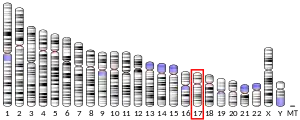Transcription elongation factor SPT6 is a protein that in humans is encoded by the SUPT6H gene.[5][6]
References
- 1 2 3 GRCh38: Ensembl release 89: ENSG00000109111 - Ensembl, May 2017
- 1 2 3 GRCm38: Ensembl release 89: ENSMUSG00000002052 - Ensembl, May 2017
- ↑ "Human PubMed Reference:". National Center for Biotechnology Information, U.S. National Library of Medicine.
- ↑ "Mouse PubMed Reference:". National Center for Biotechnology Information, U.S. National Library of Medicine.
- ↑ Chiang PW, Wang S, Smithivas P, Song WJ, Ramamoorthy S, Hillman J, Puett S, Van Keuren ML, Crombez E, Kumar A, Glover TW, Miller DE, Tsai CH, Blackburn CC, Chen XN, Sun Z, Cheng JF, Korenberg JR, Kurnit DM (Sep 1996). "Identification and analysis of the human and murine putative chromatin structure regulator SUPT6H and Supt6h". Genomics. 34 (3): 328–33. doi:10.1006/geno.1996.0294. PMID 8786132.
- ↑ "Entrez Gene: SUPT6H suppressor of Ty 6 homolog (S. cerevisiae)".
Further reading
- Andersson B, Wentland MA, Ricafrente JY, et al. (1996). "A "double adaptor" method for improved shotgun library construction". Anal. Biochem. 236 (1): 107–13. doi:10.1006/abio.1996.0138. PMID 8619474.
- Nagase T, Seki N, Ishikawa K, et al. (1996). "Prediction of the coding sequences of unidentified human genes. V. The coding sequences of 40 new genes (KIAA0161-KIAA0200) deduced by analysis of cDNA clones from human cell line KG-1". DNA Res. 3 (1): 17–24. doi:10.1093/dnares/3.1.17. PMID 8724849.
- Yu W, Andersson B, Worley KC, et al. (1997). "Large-scale concatenation cDNA sequencing". Genome Res. 7 (4): 353–8. doi:10.1101/gr.7.4.353. PMC 139146. PMID 9110174.
- Chiang PW, Stubbs L, Zhang L, Kurnit DM (1998). "Isolation of murine SPT5 homologue: completion of the isolation and characterization of human and murine homologues of yeast chromatin structural protein complex SPT4, SPT5, and SPT6". Genomics. 47 (3): 426–8. doi:10.1006/geno.1997.5137. PMID 9480761.
- Wu-Baer F, Lane WS, Gaynor RB (1998). "Role of the human homolog of the yeast transcription factor SPT5 in HIV-1 Tat-activation". J. Mol. Biol. 277 (2): 179–97. doi:10.1006/jmbi.1997.1601. PMID 9514752.
- Strausberg RL, Feingold EA, Grouse LH, et al. (2003). "Generation and initial analysis of more than 15,000 full-length human and mouse cDNA sequences". Proc. Natl. Acad. Sci. U.S.A. 99 (26): 16899–903. Bibcode:2002PNAS...9916899M. doi:10.1073/pnas.242603899. PMC 139241. PMID 12477932.
- Endoh M, Zhu W, Hasegawa J, et al. (2004). "Human Spt6 stimulates transcription elongation by RNA polymerase II in vitro". Mol. Cell. Biol. 24 (8): 3324–36. doi:10.1128/MCB.24.8.3324-3336.2004. PMC 381665. PMID 15060154.
- Gerhard DS, Wagner L, Feingold EA, et al. (2004). "The status, quality, and expansion of the NIH full-length cDNA project: the Mammalian Gene Collection (MGC)". Genome Res. 14 (10B): 2121–7. doi:10.1101/gr.2596504. PMC 528928. PMID 15489334.
- Olsen JV, Blagoev B, Gnad F, et al. (2006). "Global, in vivo, and site-specific phosphorylation dynamics in signaling networks". Cell. 127 (3): 635–48. doi:10.1016/j.cell.2006.09.026. PMID 17081983. S2CID 7827573.
This article is issued from Wikipedia. The text is licensed under Creative Commons - Attribution - Sharealike. Additional terms may apply for the media files.





